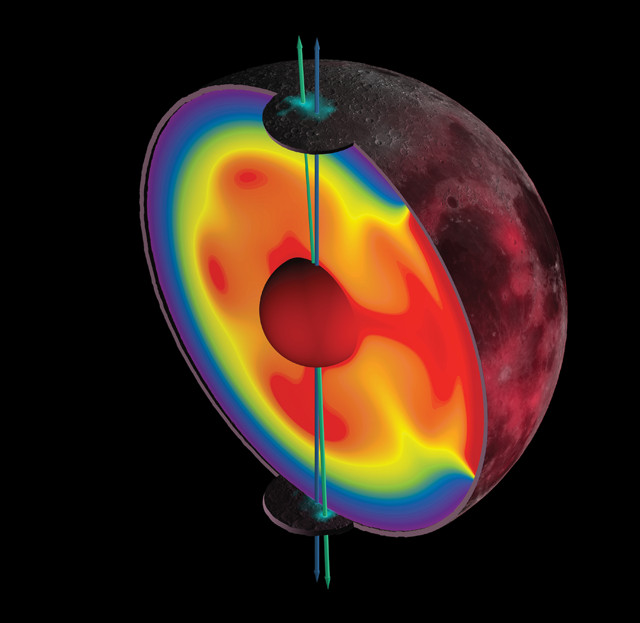
by Lucas Joel Thursday, July 14, 2016

Lunar true polar wander is indicated by the presence of two antipodal ice deposits, each located about 5.5 degrees from the moon's present-day poles, according to new research. Credit: James Kean.
In 2009, NASA’s LCROSS mission sent a rocket crashing into a crater near the moon’s south pole, sending debris into space and confirming earlier indications of the presence of water ice on the moon. In a new study, researchers have found that the distribution of ice around the lunar poles doesn’t quite match what scientists initially expected. Instead of ice deposits centered only on the present-day poles — the darkest, coldest spots on the modern moon — ice appears to also be concentrated several degrees away from either pole. And, these off-axis deposits are directly across from one another, or antipodal, on opposite sides of the moon. The reason for this, the study’s authors say, is that the moon, shortly after its formation, shifted off its original rotation axis, causing new ice deposits to form around the new poles while older ice deposits remained at the original poles.
Matt Siegler, a planetary scientist at the Planetary Science Institute in Arizona and lead author of the new study in Nature, and his colleagues analyzed observations of hydrogen abundance on the lunar surface from NASA’s Lunar Prospector, which orbited the moon from 1998 to 1999. Water has a lot of hydrogen in it compared to the rocky debris that makes up most of the moon, so relatively high concentrations of lunar hydrogen are typically taken as evidence of ice. Siegler’s team noticed that “on the exact opposite side of the planet from where we crashed LCROSS was the other highest hydrogen concentration on the moon,” he says. “There was this symmetry in polar ice deposits that had not been noticed before.”
But the antipodal ice deposits actually occur about 5.5 degrees away from the current lunar poles. This, Siegler says, is evidence that the moon must have shifted from its initial rotation axis — a process known as true polar wander. “True polar wander is a physical change of where the rotational axis is on the map,” Siegler says. On Earth, true polar wander occurs “over long times in response to continents moving mass around” at the surface of the planet, which changes the planet’s orientation.
So what might have moved the lunar axis? Early in the moon’s history, about 4.5 billion years ago, a massive amount of basalt erupted, forming a large volcanic province known as Oceanus Procellarum; today, this region is visible as a widespread dark area on the near-side of the moon. Rich in radioactive uranium and thorium, the province was warmer and therefore less dense than the surrounding, already-solidified material, and could have shifted the moon’s mass balance, causing the poles to wander, Siegler says. Given the position of the volcanic region and orientation of the moon’s current rotation axis, it’s the most likely cause, he and his colleagues suggested. “You could’ve almost predicted that the moon would’ve moved this way from the thermal evolution of the [province],” he says.
Even with an explanation for why the ice deposits are where they are, however, the question of how the ice has lasted so long after the poles shifted is still unclear, says Ian Garrick-Bethell, a planetary scientist at the University of California at Santa Cruz who was not involved in the study but wrote an accompanying commentary in Nature. Ice persists near the moon’s poles largely because those areas receive little to no sunlight. But with the ice shifted away from the polar axis, it means that at least some lunar ice is exposed to sunlight.
For “ice to be stable in a vacuum for billions of years, the temperature has to go down to about 110 Kelvin [minus 163 degrees Celsius],” Garrick-Bethell says. Temperatures that low can occur even in sunlit regions on the moon, though, so lunar ice shouldn’t necessarily have all evaporated just because it is not right at the poles, he says. But, he adds, lunar soil “has been exposed to churning over and over again by meteoroids,” which could have “liberated a lot of the water” into space. It’s possible that an equilibrium has been established, with some of the water ice being liberated and some being buried beneath the soil, he says, but the details of how the ice has survived for billions of years still need to be worked out.
© 2008-2021. All rights reserved. Any copying, redistribution or retransmission of any of the contents of this service without the expressed written permission of the American Geosciences Institute is expressly prohibited. Click here for all copyright requests.